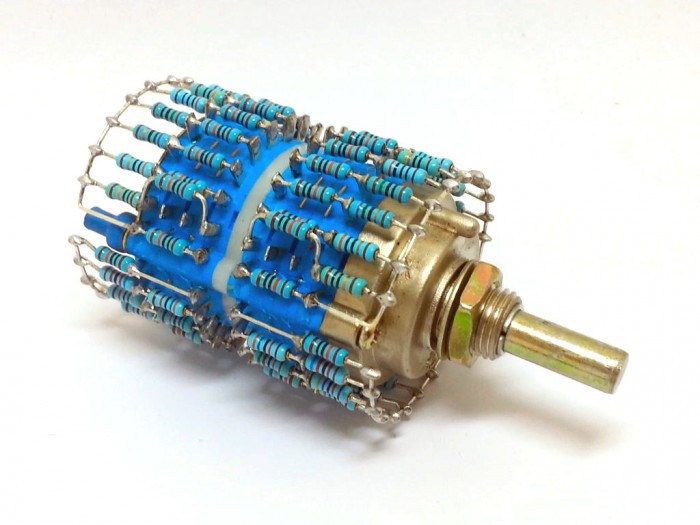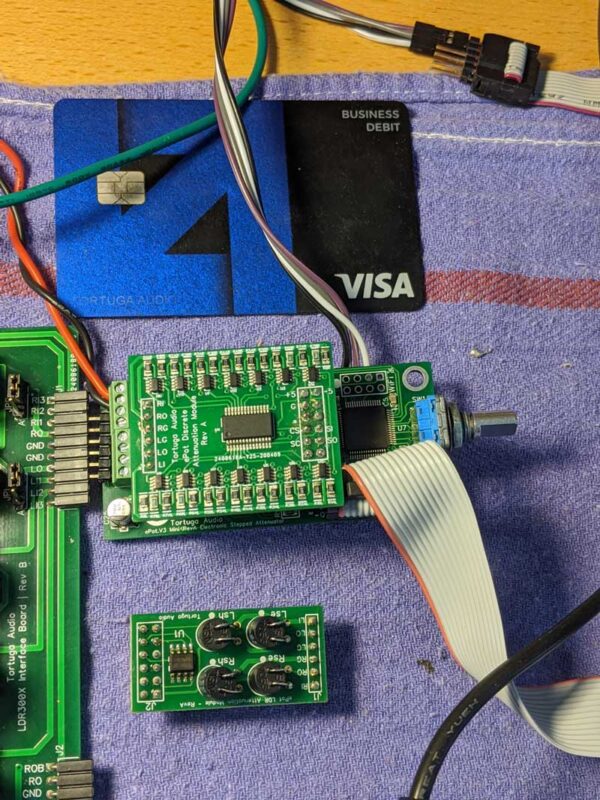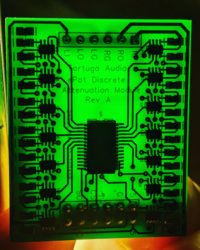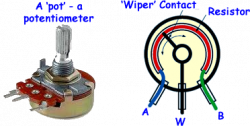What is a stepped attenuator?
The short answer is a stepped attenuator is a type of volume control device.
The longer version takes a bit of introduction. Almost everyone has heard of, used or seen a potentiometer (or “pot”) which is the most common of all volume control devices. A key characteristic of a pot is that it’s smoothly continuous meaning that as you turn the pot the volume changes smoothly. There are no “steps” per se with a pot.
In contrast, a stepped attenuator changes volume in discrete steps. A stepped attenuator is really a big mechanical switch with many positions and each position gives you a different volume level. The image below shows a typical mechanical stepped attenuator with multiple switched resistor pairs.

Stepped attenuators exist for the simple reason that audio enthusiasts find that they sound better than potentiometers. And they do!
But stepped attenuators do have their drawbacks. Top of the list is that most are too coarse in that each volume step is often larger than ideal. So why not just add more steps? Because the mechanical complexity goes up dramatically as does the physical size not to mention the cost. Most do not have more than 30 steps.
Next on the list are sonic artifacts from the switching process such as clicks and pops as the volume is turned up or down. Some are better than others at mitigating this. In the end you are unavoidably left with dozens of moving/sliding mechanical contact points each of which is prone to corrosion, wear and misalignment over time.
Last but not least almost all mechanical stepped attenuators are manual devices. Forget using a remote control. You have to get up, walk to the panel, grab a big knob (you need the torque!) and turn it by hand to get the volume you want. Click, click, click, click.
An electronic stepped attenuator alternative
The ePot.V3 (also referred to as either the ePot or V3) is an electronic alternative to a mechanical potentiometer or stepped attenuator that offers advantages that no mechanical attenuator can match. In addition to being a better stepped attenuator it’s also a complete preamp controller that can handle not only volume control, but also input switching, on/off power switching, muting, channel balance adjustment, and an interactive user interface that includes both remote control capability and a high contrast OLED display.

The ePot.V3 is an analog audio device with a software driven digital heart. It is the successor product to Tortuga Audio’s popular LDR.V25 Preamp Controller which traces its roots back to 2012 and our very first electronic stepped attenuator based on light dependent resistors (LDRs).
The new “ePot” designation is meaningful for 2 reasons.
First, it explicitly recognizes that, like its predecessors, the V3 is indeed an “e”lectronic “pot”entiometer and stepped attenuator.
Secondly, the ePot.V3 model we call the “Mini” is literally a direct physical replacement for a volume potentiometer or mechanical stepped attenuator insofar as it through-mounts directly into a typical front panel, is secured via a nut and washer, to which you then attach a conventional control knob just as you would to any pot or stepped attenuator.
Two models | one common design
There are two ePot.V3 models; the larger full featured ePot.V3 Max and the smaller ePot.V3 Mini with reduced capabilities but uniquely capable of direct panel-mounting and replacing a conventional volume pot in new or existing preamps.
Both models share a common hardware design and both utilize the same core software.
The ePot.V3 Max
The full size Max is a 2.7 x 4.4 inch chassis mounted stepped attenuator and preamp controller. The Max can control volume, channel balance, provide on/off power command signal, mute output, switch up to 6 stereo input channels (no external relays required), handles both single-ended and balanced audio (2 boards needed for balanced), and has the built-in ability to calibrate any LDR Attenuation Module including adjustable input impedance. The Max is remote controlled via an Apple remote. The Max can also be controlled locally at the panel via a rotary encoder. While the Max can operate with only a single LED status feedback light it’s ideally suited to operate with an interactive menu driven 256 x 64 bit high contrast OLED display which expands its functionality and ease of use. The Max offers excellent performance as a passive attenuator or upstream of a gain/buffer stage in an active preamp.

The ePot Mini
At 1.35 by 2.9 inches, the Mini is 67% smaller than Max and is even smaller than a credit card. A key feature of the Mini is the board mounted rotary encoder that allows the Mini to be panel mounted similar to any potentiometer or stepped attenuator. The Mini has many of the same capabilities as the Max but in exchange for the smaller size does not offer input switching and does not have the built-in ability to calibrate its LDR Attenuation Module. However, it most definitely can also be remote controlled and also integrates with the same high contrast interactive OLED display as the Max.
The table below summarizes the similarities and differences between the the two ePot.V3 models.
| ePot.V3 Max | ePot.V3 Mini | |
|---|---|---|
| Size | 2.7 x 4.4 inch | 1.35 x 2.9 inch (67% smaller) |
| Input Switching | Yes – built-in switching between 6 stereo input channels | No switching – single stereo channel |
| Mounting | Chassis mounted w/ standoffs (not included) | Panel mounted via integral board mounted encoder (like a potentiometer) |
| Balanced Audio | Yes – requires 2 separate boards and a 2 wire serial data link | No – single-ended only |
| LDR Module Calibration | Yes – built-in | No – Uses replaceable plug-in LDR module or you can use a separate ePot.V3 Max to calibrate any LDR module for any Mini |
| Attenuation Type | Plug-in LDR module | Same |
| Controls | * Rotary encoder (externally mounted) * Apple remote control (infrared) | Same except the rotary encoder is mounted directly to the Mini board by default. If you wish you can order a Mini without the encoder installed. This way you can mount the encoder in the front panel and locate the Mini board itself elsewhere. |
| Display | * Status LED * Optional OLED Display (with encoder and IR receiver interface) | Same except OLED and Status LED are mutually exclusive since they both use the same header |
| Auxiliary Control Header | 6 bit signal for controlling external devices | No |
| WiFi Module | Future capability | Same |
| Microcontroller | 100 pin STM32F2 microcontroller | 64 pin STM32F2 microcontroller |
| Firmware Update | Yes – via USB to 2-wire serial UART link | Same |
| Remote Control | Yes – via Apple remote and externally mounted IR receiver | Same |
| Manual Control | Yes – via rotary encoder (externally mounted) | Yes – via integral board mounted rotary encoder |
New plug-in LDR attenuation module
Like its predecessors, the ePot.V3 offers high performance attenuation using light dependent resistors (LDRs). LDRs offer a very pleasing clean, clear, unveiled, neutral, colorless, yet natural organic sounding volume control with remarkable bass performance. The reader is referred to the following link for a more in depth discussion about LDRs.
The V3 LDR Attenuation Module is a new LDR module design where all 4 LDRs are now mounted together on a single board along with an EEPROM memory chip that holds the impedance and attenuation setting data that are unique to each set of LDRs. The LDR Attenuation Modules plugs directly into either ePot.V3 model.
The LDR Attenuation Module provides 100 attenuation steps of ~ 0.6 dB/step over a -60 to 0 dB attenuation range. While we call them attenuation “steps” the transitions between steps are smoothly continuous since LDRs are themselves true analog devices. There are no audible stepping artifacts and the control is smooth and precise over the full range.
New plug-in discrete attenuation module

The ePot.V3 introduces a new alternative to Tortuga Audio’s LDR based attenuation module for users who looking for the sound and measured performance of stepped attenuators with more conventional low-distortion discrete resistor pairs.
Thin film resistors are precision low noise passive devices made from nickel-chromium metal deposited on to a ceramic substrate. Referred to as stepped logarithmic attenuation, 7 fixed resistor pairs per channel provide stepped attenuation in increments of 0.5 dB, 1 dB, 2 dB, 4 dB, 8 dB, 16 db, and 32 dB. These 7 stages provide 127 steps of super smooth attenuation in ~0.47 dB increments over a -63.5 to 0 dB attenuation range.
While each step is truly discrete requiring one or more resistor pairs to connect and/or disconnect from the attenuation circuit this switching is done via ultra-fast, and ultra low-distortion, break-before-make analog switches. The result is super smooth switching with no audible artifacts. Left and right channel switching is done independently as well so that channel balance adjustments are also possible; something unheard of with discrete mechanical stepped attenuators.
Which attenuation module? (try both!)
Both attenuation module types are available as interchangeable plug-in modules that plug directly into both ePot.V3 models via the same pair of sockets. You don’t have to tell the V3 what type of attenuation module you are using. Plug in either attenuation module type, restart the board, and it figures that out on its own.
As to which one to choose for your ePot.V3, why not try booth and decide for yourself which you prefer in your system.
Improved LDR control & calibration
The ePot.V3 introduces a significantly improved LDR control scheme compared to all prior models.
The light source inside a “light” dependent resistor is actually an LED. As with any LED, the light intensity emitted by the LED is directly proportional to the current running through it. And by controlling light intensity you control the resistance level of the LDR. Hence, precise current control is synonymous with precise resistance control. In the past we’ve accomplished this indirectly with voltage control.
With the V3 we have replaced voltage control with precision closed loop LDR current control. Precision current control decouples LDR performance from power supply voltage levels resulting in more predictable, stable and repeatable LDR performance over a wide range of current.
In addition to precision current control, the ePot.V3 also has an improved LDR calibration system that replaces the previous 12 bit system with a simpler yet more precise 16 bit approach. LDR calibration is a built-in feature of the ePot.V3 Max. The reader is referred to the following link for a more in depth discussion of LDR calibration.
As a result, the sonic performance of the ePot.V3 running with LDR attenuation is now at the highest levels we’ve achieved to date.
Visual feedback & display options
The ePot.V3 will operate under a reduced set of control functions without the need for any visual feedback. These basic functions include power on/off, volume control, channel balance control & reset, muting, input switching (Max only), and stereo/mono switching (Max only).
Minimal feedback is provided through the optional attachment of a single status LED which indicates on/off status and briefly flashes acknowledging a control input from the remote.
Full control functionality and feedback requires our graphical OLED display together with a rotary encoder and remote.
The following table summaries the differences in available control functionality and information with various feedback options for both the Mini and Max models.
| OLED Display | Status LED | |
|---|---|---|
| Status Info | Alphanumeric and/or graphical information | LED on, off or blinking |
| Volume Level | Yes | No |
| Current Input | Yes | No |
| Balance Level | Yes | No |
| Calibration (LDR only) | Detailed status display | Periodic blink count indicating which LDR (1 - 4) is in calibration. Continually blinking indicated calibration failure (possible bad LDR). |
| Other controls & status info | Numerous | None |
ePot.V3 specifications
The following table is a fairly comprehensive listing of the specifications of the V3 hardware. This table does not include details on the operation and control of the ePot.V3 or ePot.V3 Mini; such information will be posted once it becomes available.
| Criteria | |
|---|---|
| Attenuator/preamp type | Passive electronic stepped attenuator & preamp controller. There is no active manipulation of the audio signal by any power supply. The audio signal is optically isolated from the control system. |
| Attenuation module | Operates interchangeably with either a plug-in LDR (light dependent resistor) Attenuation Module or a plug-in Discrete Resistor Attenuation Module * LDR Attenuation Module – 100 0.6 dB steps over a 0 to 60 dB range plus 1 additional muting step. A microcontroller uses 100 stored calibration/attenuation command values for each of the 4 attenuation LDRs for a given input impedance and sends commands for the current volume step to a 4 channel 16 bit DAC that in turn drives 4 independent precision closed loop LDR current controllers. * Discrete Attenuation Module – 127 0.5 dB steps over a 0 to -63.5 dB range plus 1 additional muting step. Selects up to 7 series/shunt pairs of logarithmically arranged discrete resistors per channel to achieve 127 steps of attenuation over a 0 to -63.5 dB range at a fixed 60k input impedance. |
| Gain | Unity (1x) gain – no amplification |
| Buffering | No active or passive input or output stage buffering or coupling |
| Input impedance | * LDR Attenuation Module – 20k by default | may configure up to 9 additional impedance settings each adjustable between 1k and 99k and switch between the settings with live music to optimize input impedance for their system. * Discrete Attenuation Module – 60k fixed |
| LDR Calibration | * ePot.V3 Max – Integrated offline LDR module measurement and calibration against 100 attenuation resistance values that vary depending on the current input impedance setting with results stored in an EEPROM memory located on the plug-in LDR module. Calibration is an offline operation and does not occur during normal operation of the attenuator. Calibration is user initiated by can also be configured for periodic automatic operation when unit is otherwise turned off. Changing an input impedance to a new value within a given setting requires running a calibration cycle at that new value. * ePot.V3 Mini – no built-in LDR calibration |
| Number of Channels | 2 independent channels (stereo) |
| Channel Balance Accuracy | Within 0.5 db over full attenuation range |
| Audio Signal Ground | No connection of signal grounds to power ground within controller, however, audio signal ground must share common ground with power supply via an external star ground point in order for LDR self-calibration feature to function properly. |
| Audio Inputs | Single Ended | ePot.V3 Max – 1 board accommodates up to 6 switchable single-ended stereo (2 channel) inputs ePot.V3 Mini – 1 stereo input only (no input switching) |
| Audio Inputs | Balanced | ePot.V3 Max – 2 boards accommodate up to 6 switchable balanced stereo (2 channel) inputs. With 2 boards it’s possible to configure a mix of single-ended and balanced inputs. ePot.V3 Mini – not for balanced audio |
| Audio Input Switching/Isolation | ePot.V3 Max – Input switching via analog switches | typical 2 ohm resistance when on | in excess of 10 megaohms when off | no mechanical relays in signal path. ePot.V3 Mini – no input switching |
| Audio Output Switching/Isolation | ePot.V3 Max – Attenuation LDRs minimize output during muting | Analog switches isolate output signals when undergoing calibration ePot.V3 Mini – No output isolation |
| Total Harmonic Distortion | LDR Attenuation Module – typically less than 0.5% Discrete Attenuation Module – typically less than 0.1% |
| Power Input | 7-30 volts DC rated at 0.5 amp via J1 |
| Power Regulation | Two stage DC-DC regulation | switching regulation followed by linear regulation for 3.3V digital power and split voltage +/-4.5-5 V for analog power |
| Processor | ARM STM32F2 32 bit microcontroller running at 100 MHz |
| Control Input | Remote | Accepts control inputs from infrared silver Apple remote or equivalent remote using 38 kHz NEC protocol and Apple commands | infrared commands received via infrared receiver module attached indirectly via display module or directly to board pins |
| Control Input | Encoder | Accepts control inputs from rotary stepped encoder with integral push button switch | encoder attached indirectly via display or can be attached directly to board pins |
| Control Input | UART | Accepts control inputs from external device using UART serial protocol and specific command codes (available upon request). |
| Display | OLED | Graphic OLED display with an intuitive, easy to use, menu based control scheme. Connects to the board via both J4 header. Requires display jumper across pins at J7.DISP pins. |
| Display | 7-Segment (legacy) | Original dual 2-digit numerical 7-segment LED display can be connected via individual J4 pins although overall functionality is not guaranteed. |
| Display | Status LED | Status LED light | connects to board via J7 |
| Mono Mode | ePot.V3 Max | Rev A – Output switchable between stereo and mono mode via LDR switch | applies on to single-ended audio ePot.V3 Max | Rev B – No mono mode ePot.V3 Mini – No mono mode |
| Firmware | Custom code written in object oriented C++ programming language |
| Firmware Update | Firmware can be updated by invoking a chip resident bootloader that communicates with an extern PC based application. Firmware interface from PC to ePot is via a USB->Serial (FTDI USB->UART) com connection. FTDI communication interface sold separately. |
| WiFi Module | Future ability to plug in a simple WiFi module via J6 that will allow the V3 to be controlled via smartphone app. |
| Printed Circuit Board | High quality nickel immersion gold pads with green solder mask |
| Power | ** Current Draw ** Single board w/ OLED display – 130 ma Dual boards (balanced or dual mono) w/ single OLED display – 210 ma ** Supply Voltage ** 9-30 volts DC |


